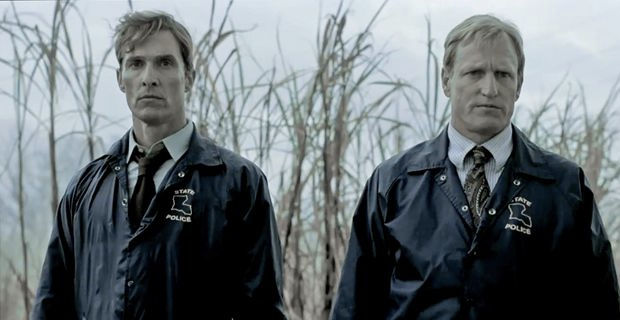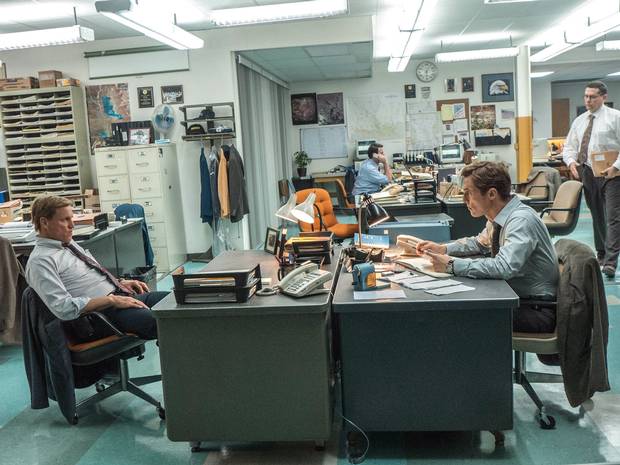Week Eight – The Poetics of Complex Narrative
HBO has built a brand identity and status around series that are distinguished by complex narratives, with shows such as The Sopranos (1999), Six Feet Under (2001), Curb Your Enthusiasm (1999), The Wire (2002) and Game of Thrones (2011) examples of this. By looking at the pilot episode of HBO’s latest, “Sunday night crime drama,” (Hale, M; 2014) True Detective (2014) we can see how, “complex television employs a range of serial techniques,” with the underlying theory that, “a series is a cumulative narrative that builds over time, rather than resetting back to a steady-state equilibrium at the end of every episode” (Mittel, J; 2014).
The show traces two Louisiana State Police Criminal Investigations Division homicide detectives, Detective Rust Cohle (Matthew McConaughey) and Detective Marty Hart (Woody Harrelson) in their search for a serial killer across seventeen years. The show takes on a stereotypical police procedural shell and then hybrids this genre in the forms of thriller, drama and southern gothic to form an immersive story world that help lure the audience in. Through this world the show demands, “intensified viewer engagement focused on both diegetic pleasure and formal awareness” (Mittell, J; 2014) and requires a form of deep attention from the viewer. The framework of the show is not anything new, with the pilot episode setting up a ritualistic murder of a woman, to which Cohle suspects a serial killer and no one but Hart believes him. But what is innovative is the shows, “chilly, restrained mood of foreboding,” the narrative (Hale, M; 2014). This aspect is partly achieved due to the anthology format of the series, meaning that each season there is a different cast of characters and story, therefore blurring the line between cinema and television as the show occurs more like a mini-series. Furthermore, the long-form and plot narrative also mean each episode doesn’t necessarily guarantee some sort of ideological closure or reassurance for the viewer, thus allowing their engagement with the show to exist over the series rather than a single episode.
Complex narrative can be viewed in terms of a mode of television storytelling that is orientated around the narrative events of kernels and satellites as a way to connect and give importance to events within the narrative. We can view the partnership between Cohle and Marty as a kernel, a, “narrative moment[s] that give rise to cruxes in the direction taken by events,” and are central to the cause-and-effect of the plot; as it’s their relationship that is key to the development of this case and story. While something like Cohle buying drinks for the women at the bar can be seen as a satellite, “a minor plot event,” that can be deleted without disturbing the logic of the plot, “though the omission will… impoverish the narrative aesthetically” (Chatman, S;1978) as it develops Cohles character and lost-hope view on life. Satellites are therefore more about an idea of texture and tone in the world building of the show, in order to, “complet[e] the kernel… [and] form the flesh on the skeleton” (Chatman, S; 1978).
True Detective’s skeletal core resides in the story being told in, “two tracks: in 1995, when Cohle and Hart begin their investigation, and in 2012, when the case has been reopened, and both are being questioned by a second set of detectives” (Hale, M; 2014). Through this use of temporal structure, clues are gathered surrounding the original case in 1995 and the audience begins to be shown what went wrong with it. The pilot episode differentiates these two tracks with the differences in characters – Cohle is physically different having grown a beard and Marty being agitated as he talks about his relationship with Cohle – and in the aesthetics of the filming – with the footage being grainy to emulate a police interview video. Throughout the episode we keep going back to these roomed interviews and it’s not until we enter the room through the lens of the detective’s camera that we are placed in the present space with Cohle. The use of fractured time lines and the neglect to situate the viewer in these moments give the show depth and alludes to the complex relationship these two men have.
Distinctive of the show is only having two key character stories driving the narrative, which is reinforced by the female characters not really having established characters but being cardboard cut-outs for the main characters to interact and have another form of relationship with. This idea of masculinity is significant of the HBO brand, along with the high production values of the show making it cinematic in style. The show’s use of space is particularly filmic, from divided Police office sets and broad landscapes, displaying the broken humanity in a wrecked America.
The pilot episode of True Detective is exemplary of how complex narrative elements can come together to make a show quality television. Through the use of such things as fractured time lines, a hybrid genre and cinematic aesthetics, the show identifies and markets itself as a multifaceted engagement all about the journey and not the destination.
References
Chatman, S 1978. Story and Discourse: Narrative Structure in Fiction and Film, Cornell Univeristy Press, United States of America, pp. 53-56.
Hale, M. ‘A Coupling as Bizarre as the Murder: McConaughey and Harrelson Star on ‘True Detective,’ on HBO,’ The New York Times, 2014: http://www.nytimes.com/2014/01/11/arts/television/mcconaughey-and-harrelson-star-in-true-detective-on-hbo.html?_r=0, October 2014.
Mittel, J 2014, ‘Complex TV’, Media Commons Press, http://mcpress.media-commons.org/complextelevision/complexity/, October 2014.


